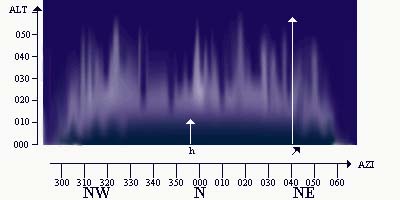Clone of Main observing details required
Basic information required are your location, the double date of the evening and morning of the night concerned (e.g. 18/19th November 1982), the 24 hour clock time (noting U.T. or B.S.T.) and a description of the aurora in writing with or without sketches or photos. More experienced observers should try to observe each change in form and make notes in aurora code at about 15 minute intervals or at the times of change.
Magnetic midnight takes place at about 22:00 hrs U.T. in the United Kingdom so that it is useful to scan the sky nightly at this time when the probability of seeing an aurora is at its highest. Aurorae are more likely to be seen at the equinoxes but for statistical purposes it is desirable to keep an all year round watch for activity. The frequency of the aurora tends to follow the sunspot cycle but peak activity may appear a year or so after sunspot maximum.
In order to measure the position of the auroral forms an observer may make a simple theodolite, or may obtain the azimuths of horizon features from a map, or may convert from the declination and right ascension of the stars in the background. Angles in the sky can be estimated by using the hand at arm’s length as a measure : the distance across the fingers is about 10 degrees. This can be checked by counting hand’s-breadths from the horizon to the zenith or round the horizon. (Each observer will have his own best measure – across the finger tips or across the knuckles – depending on the length of his arm and on~how he chooses to hold his hand). There is a tendency for observers to over-estimate angles of altitude if an instrument is not used. A meteorological hand held cloud alidade can be used for height measurement, and these are simple to make at home.
|
The above Diagram illustrates the key angular measurements required to define the position of an auroral structure: h = the base height in degrees above the horizon; h = 10 degrees.
|
In a large and active display it is generally impractical to attempt a complete description of all the forms and types of activity observed; what can be useful is an indication of the time of greatest activity, greatest extent or greatest brightness.
The intensity of auroral light is often too low to stimulate the colour-sensitive parts of the eye and auroral forms may have the grey-white appearance of cloud lit by weak moonlight But at higher intensities (or to a well dark adapted eye) aurora exhibits a variety of colours, mainly greens and deep reds. Look especially for red rays and patches above or to the side of the main display and for red borders to the lower edges of rays, bands and arcs. Interference filters passing the auroral emission colour green of 5577 angstroms may be used to search for auroral light in cloudy, moonlight, hazy or town lit conditions. Such filters are expensive to buy.
| The British Astronomical Association supports amateur astronomers around the UK and the rest of the world. Find out more about the BAA or join us. |

